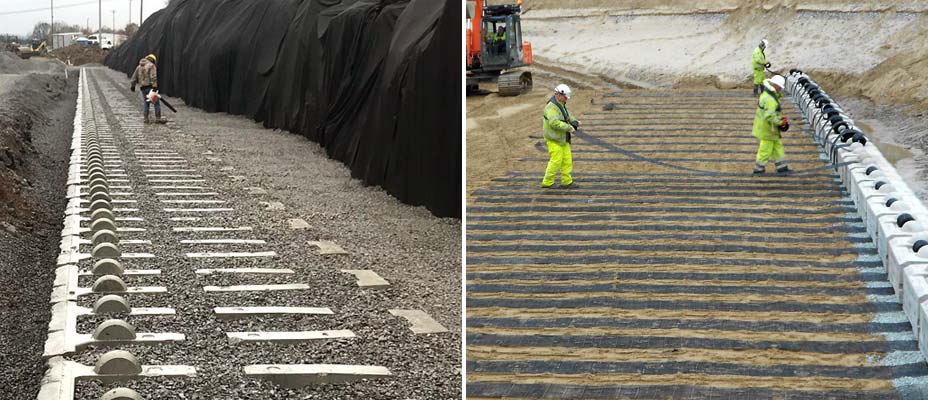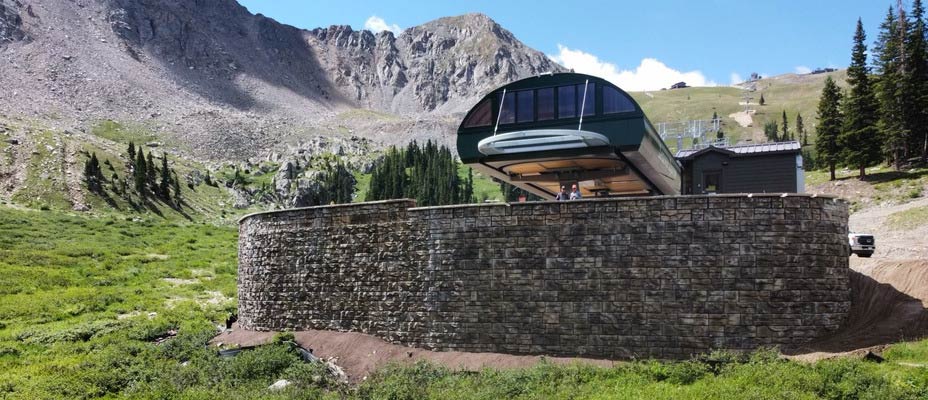What Are The Differences Between Gravity Retaining Walls and Mechanically Stabilized Earth (MSE) Retaining Walls?

Avg. Read Time: ±5 min
Retaining walls serve as vital engineering structures, tasked with holding back soil, preventing erosion, and providing stability to structures and landscapes in residential, commercial, and public works projects. Among the diverse array of retaining wall solutions, two prominent types are gravity retaining walls and mechanically stabilized earth (MSE) retaining walls. While both serve the fundamental purpose of retaining soil, they each employ distinct mechanisms and materials to achieve this goal.
Below, we’ve highlighted the most significant differences between gravity and MSE retaining walls.
The Base Course Short on time? Here are this article’s key takeaways…
Gravity retaining walls and mechanically stabilized earth (MSE) retaining walls both serve the fundamental purpose of retaining soil but employ distinct mechanisms and materials to do so. Gravity walls rely solely on the weight of their retaining wall blocks to counteract lateral soil pressure and deliver structural stability.
MSE walls depend on the reinforced soil structure behind the wall face for structural stability. This is achieved through the use of geosynthetic soil reinforcement material such as geogrid or metal straps.
MSE wall installation is similar to gravity wall construction but includes several noteworthy additional steps. Gravity walls can exceed heights of 20 ft (6.1 m) depending upon the individual site.
The additional reinforcement used to install MSE wall structures allows them to achieve heights of 60 ft (18.3 m) or more, in certain site applications. Pricing differences between gravity and MSE walls are generally dependent on the site and overall project scope.
How do they perform their jobs?
Gravity walls rely solely on the weight of their retaining wall blocks to counteract lateral soil pressure and deliver structural stability. Typically blocks of different sizes comprise gravity walls.
MSE walls depend on the reinforced soil behind the wall for structural stability. This is achieved through the use of geosynthetic soil reinforcement material such as geogrid or metal straps attached either directly to the wall blocks or between the tops and bottoms of stacked blocks, employing friction to secure the material. Geogrid is a geosynthetic material typically made from polymers such as polyester, polyethylene, or polypropylene. It consists of a grid-like structure of tensile elements arranged in a grid pattern.
How are they installed?
The installation of gravity walls includes several steps:
- Site Preparation: Before construction begins, the site must be prepared by clearing, grading, leveling, and compacting the area where the retaining wall will be installed.
- Leveling Pad Preparation: The leveling pad typically consists of a leveled and compacted base material, such as crushed stone or concrete, which provides a solid surface to begin the wall structure.
- Placement of Base Course: The first course, or base course, of the retaining wall is laid directly on the prepared leveling pad. This course is typically composed of large, heavy blocks that provide the initial stability and weight necessary to resist soil pressure.
- Layering and Stacking: Subsequent courses of blocks are stacked on top of the base course in a running bond pattern and following the design specifications of the retaining wall.
- Compaction and Backfilling: As the wall is constructed upwards, backfill material is placed behind the wall and compacted in layers. This backfill material helps to further stabilize the wall and provides additional resistance against soil pressure.
- Drainage Installation: Installation of a wall-specific drainage system shall take place during construction. Proper drainage is crucial for preventing the buildup of hydrostatic pressure behind the retaining wall, which can lead to instability and failure. Drainage pipes and free-draining soil columns are often installed directly behind the wall blocks to quickly collect drainage and divert or outlet water away from the structure.
- Finishing Touches: Once the retaining wall is constructed to the desired height, any necessary finishing touches are applied. This may include adding caps to the top of the wall for a polished appearance, installing barriers or fencing, as well as addressing any landscaping or aesthetic considerations.
MSE wall installation is similar to gravity wall construction but includes several noteworthy changes.
- Site Preparation: Similar to gravity retaining walls, the site must be cleared, graded, and compacted before construction begins. This ensures a stable base for the MSE wall.
- Leveling Pad Preparation: The leveling pad is typically leveled and compacted, and sometimes a layer of geotextile fabric may be placed to prevent soil erosion and provide separation from the underlying soil.
- Placement of Base Course: Like gravity walls, the base course blocks are placed on the leveling pad. In comparison to gravity walls, the bottom blocks of MSE walls are typically the same size throughout the entirety of the wall.
- Layering and Stacking: Blocks are stacked one course at a time in conjunction with the geosynthetic reinforcement. Geosynthetic material can be attached directly to special MSE blocks (like Redi-Rock’s proprietary notched Positive Connection blocks) or layered between block courses to take advantage of friction in anchoring the reinforced soil to the wall facing.
- Layered Backfilling: As the reinforcement layers are installed, backfill material is placed and compacted in thin layers behind the wall blocks.
- Backfill Compaction: Compaction is crucial to achieving the required density and stability of the MSE wall.
- Drainage Installation: Installation of a wall-specific drainage system shall take place during construction. Appropriate drainage is essential for preventing the buildup of water and subsequent hydrostatic pressure behind the MSE wall. Drainage pipes or weep holes may be installed at regular intervals within the backfill material to allow water to drain freely from behind the wall.
- Finishing Touches: Once the MSE wall is constructed to the desired height, any necessary finishing touches are applied. This may include securing caps to the top of the wall for aesthetics, barriers for vehicles or pedestrians, and landscaping around the wall.
How tall can they be built?
Gravity walls can exceed heights of 20 ft (6.1 m) depending upon the individual site.
The additional reinforcement used to install MSE wall structures allows them to achieve heights of 60 ft (18.3 m) or more, in certain site applications.

What type of projects are best for them?
Gravity walls can be constructed within smaller project footprints so they are commonly utilized in cut wall applications when excavation space is limited. Reduced excavation requirements can lower costs associated with labor and removal of excavated soils. Gravity walls work best when shorter wall heights are acceptable.
MSE walls are typically used in fill wall applications where backfill is already being installed. Thus adding reinforcement is not a significant or costly addition to the fill. As noted previously, MSE walls are often necessary when retaining significantly taller heights. MSE walls are generally not an ideal choice when underground utilities are present in the earth to be retained since navigating geosynthetics through them requires great care and additional time, as well as the difficulty of maintenance of these utilities post construction of the MSE wall.
Are there cost differences?
This is largely dependent on the specific project requirements and characteristics, but some general assumptions may be made regarding cost comparisons. Different block types are typically used to construct gravity and MSE walls and pricing may differ for these blocks. MSE walls require the purchase of geogrid or other geosynthetic materials to properly stabilize the wall, adding to materials expenses. Less excavation is usually necessary for gravity wall installations, saving money on labor and the export of extra backfill. Larger gravity blocks typically cost more due to the additional material associated with them.
Do the expected lifespans of the wall types differ?
Not significantly. Properly engineered and installed gravity and MSE walls typically enjoy lifespans of 100 years or more. It’s worth noting that geosynthetic materials in MSE walls possess reduction factors for corrosion and soil influence that may affect their design life. However, MSE walls still generally see 75-100 years of service.